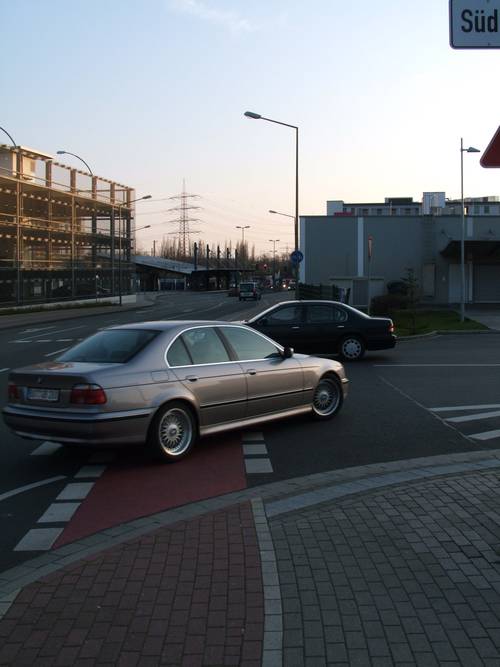Login for members:
The contents of this page are also available from the ADFC Bottrop in abridged form in print [in German] as a pamphlet. A version of the pamphlet for onscreen display (636KB) may be downloaded here. A high-definiition PDF document for reprinting also may be downloaded (note! 12.2 MB).
Do sidepaths protect?
Many cyclists, even including ones who have ridden daily for many years, believe that sidepaths protect cyclists from collisions with motor vehicles.
But also, most know from their own experience that perilous situations often occur on sidepaths. Quite often, cyclists must themselves defuse the situation by giving up their right of way or their place in line. In face-to-face conversations, most often the talk is of motorists who are turning or entering from a driveway and not paying attention to cyclists. Also, it is generally known that motorists like to use sidepaths and bike lanes to park, forcing bicyclists to merge out into the roadway on short notice and at unsuitable locations, frequently leading to dangerous maneuvers.
Nonetheless, many people believe that such situations are isolated cases, and that they do not change the fact that sidepaths are appropriate to protect cyclists from crashes. Many scientific studies, however, show the opposite: cyclists are in more danger on sidepaths than on the roadway.
Sidepath safety in traffic-safety research
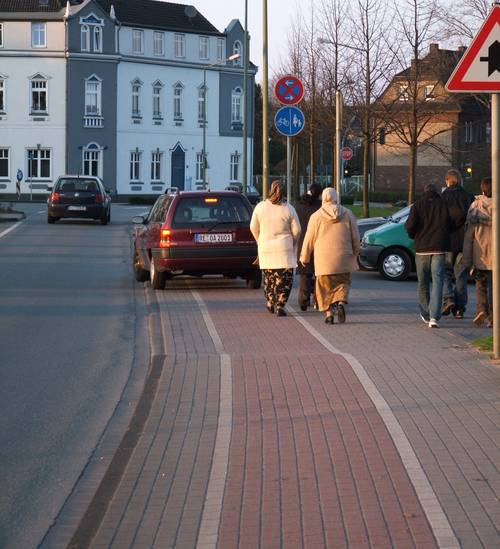
- Sidepaths are not respected: at times they are used as parking lanes, at others, as widened sidewalks.
The most well-known and comprehensive study to address these topics was published in 1992 by the Federal Traffic Institute [Bundesanstalt für Straßenwesen] (R. Schnüll e.a.: Sicherung von Radfahrern an städtischen Knotenpunkten, Bericht der Bundesanstalt für Straßenwesen zum Forschungsprojekt 8952, 1992) [Safeguarding Bicyclists at Urban Intersections, Report 8952 of the Federal Traffic Institute]. The authors of this work limited themselves to urban sidepaths which were in good condition both in terms of their location and construction.
Main streets as well as side streets were considered. Risk factors such as sidepaths on the left side (opposite the direction of traffic) were carefully removed from consideration, and also combined bikeways and sidewalks, on which there had been increased numbers of collisions between bicyclists and pedestrians.

- Especially dangerous: sidepaths and bike lanes immediately adjacent to parking lanes
Nonetheless, the results of the study were clear: the use of a sidepath incurs a risk up to five times as high at intersections as riding on the roadwway.
Even expensive and elaborate measures did not lead to a lasting decline in these risks: even when the sidepath was raised at the intersection and differently-colored from the roadway, there was still twice the risk of riding on the roadway, according to the Traffic Institute's study. Current (2006) work at the University of Lund, in Sweden, (Stefanie König, "Evaluations of the effect of rebuilt bicycle paths at intersections on arterial streets in Lund", LTH 2006; PDF, 4,6 MB) showed no lasting increase in traffic safety by coloring and raising sidepath crossings; after a brief period of habituation, the same rate of conflicts resumed as before these measures were undertaken.
Also no increase in safety away from intersections
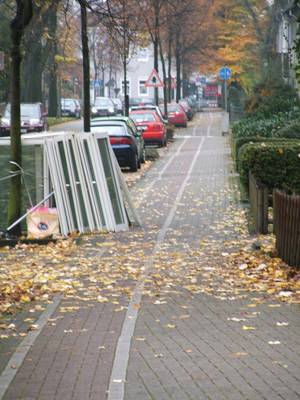
- While the roadway is clean and wide-open, the sidepath is obstructed and covered with slippery leaves. At the very least, riding here during hours of darkness becomes a game of chance.
Another study from the Traffic Institute (W. Angenendt e.a.: Verkehrssichere Anlage und Gestaltung von Radwegen, Bericht V9 der Bundesanstalt für Straßenwesen, 1993 [Traffic-safe placement and design of sidepaths, Report V9 of the Federal Traffic Institute, 1993) limited itself to bicycle crashes between intersections.
This study showed that sidepaths lead to a change in the type of crashes away from intersections. No actual reduction in the numbers of crashes could be shown. It was also established that bicycle crashes on the roadway often result from bicyclists' being too close to its edge. Many of the crashes were collisions with suddenly-opened car doors. These drashes could be avoided simply with the spacing which the police ask bicyclists to maintain.
But doesn't it work in the Netherlands?
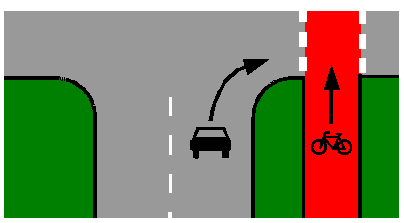
- Often leads to crashes: right-turning motorists do not pay attention to through-traveling bicyclists on their right, though these have priority.
Often, the Netherlands is held up as a shining example in discussions of sidepaths. The bicycling mode share is supposed to be especially high there, bikeways everywhere and bicycling comfortable and safe. .
In fact, cycling has a 27% mode share in our neighboring country, almost three times ours. And there are remarkably many bikeways. Bicycling is, however, not safe: the Dutch bicycle program recently had to report to the ministry of traffic that 40% of victims of traffic crashes brought to hospitals were cyclists. So, bicyclists are substantially over-represented among traffic casualties in the Netherlands, with its many sidepaths.
Radfahren - schon heute sicher
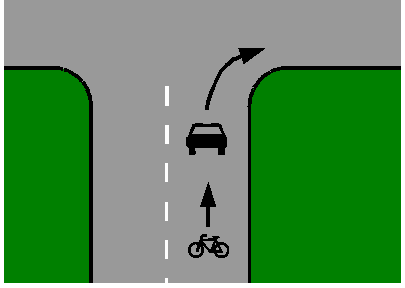
- Simple, safe and efficient in use of space: bicycle travel on the roadway.
As the data from the Federal statistics office show, bicycling in Germany is just as safe as motoring, in spite of the risks. The widespread assumption that bicycling is especially dangerous is thereby refuted. In fact, the Federal Traffic Institute expects that in 2007, the percentage of trafic fatalities among bicyclists will be less than 10%, less than the percentage of bicyclists in traffic. Bicyclists are therefore no more often victims of crashes than is average for all participants in traffic. Esperience shows that the great majority of bicycle crashes are harmless fall, which only in rare cases require a trip to the hospital. Serious injuries occur only in connection with motor vehicles, as provoked by the crossing and turning crashes where there are sidepaths. The applicable traffic law requires bicyclists to ride on the sidepath when indicated by a round blue sign. In this way, bicyclists are required, as the results of research show, to endanger themselves disproportionately. The low rate of crashes would, therefore, be reduced even more if bicyclists were allowed to do what is self-evident for all other participants in traffic: to ride where they are safest.
This is a translation of a page in German
on the site of the German Federation, ADFC, Bottorf chapter
Translation by John S. Allen, March 23, 2010.
Translation posted by permission.



